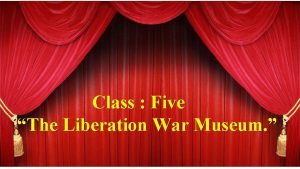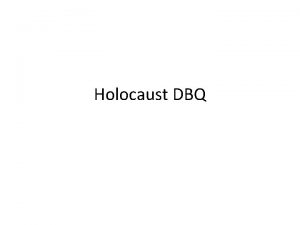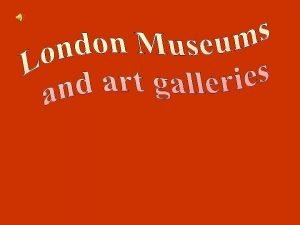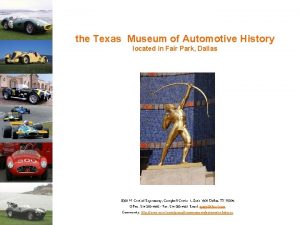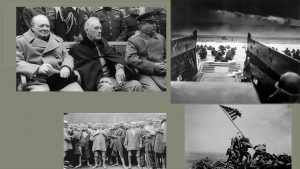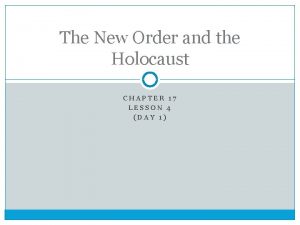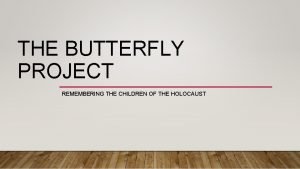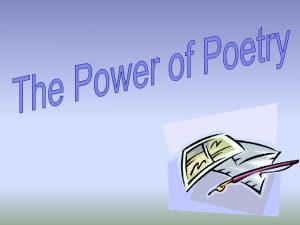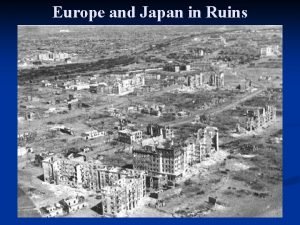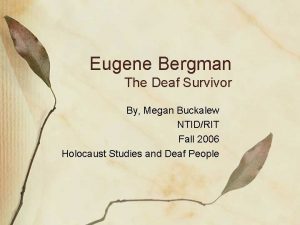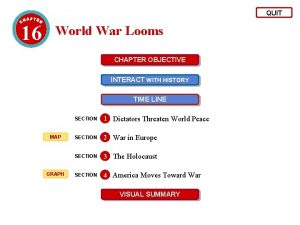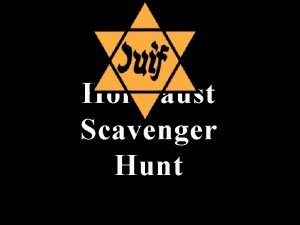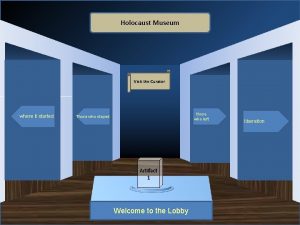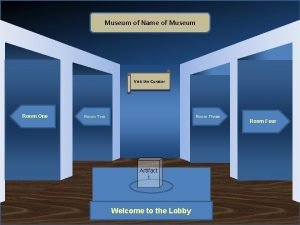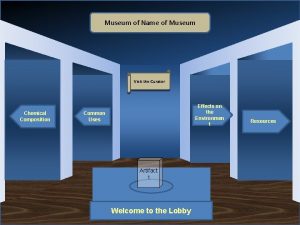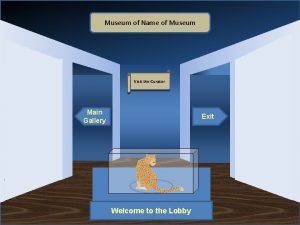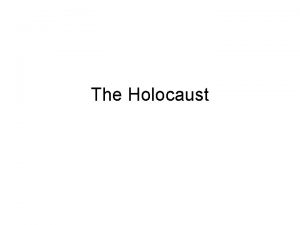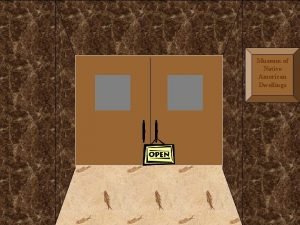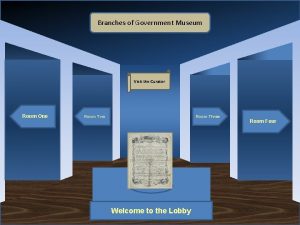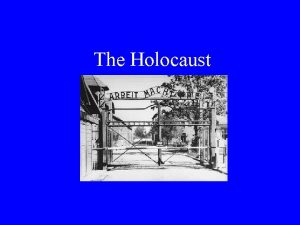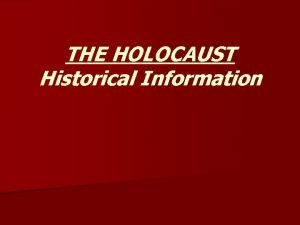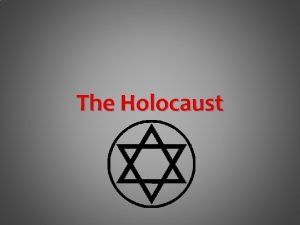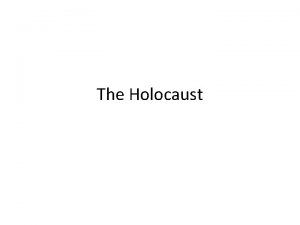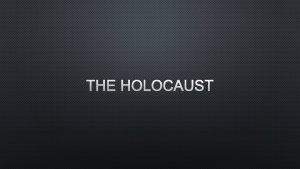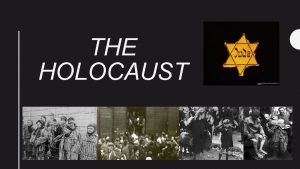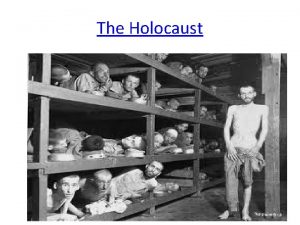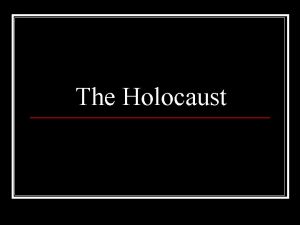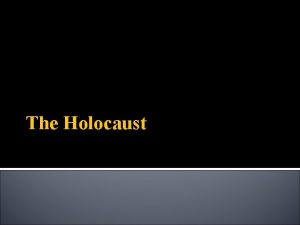History of the Holocaust Museum Visit the Curator






















- Slides: 22

History of the Holocaust Museum Visit the Curator Concentration Camps Adolf Hitler Propaganda C 3 Dimensions Anne Frank References Common Core Standards Museum Entrance Welcome to the Lobby

Name. Holocaust of Museum History of the Curator Information Kelsey Coates is a junior Elementary and Special Education double major with a concentration in Fine Arts. Melissa Naples is a junior Elementary Education Major with an ESL endorsement. Mary Broncato is a junior Education Major with a concentration in Spanish. Kendall Okner is a junior Elementary Education major with a concentration in Social Studies. We chose the topic of the Holocaust as it was a very influential and historical event of the past that we all feel individuals need to be educated about. The topics we selected show a progression of people/things that took place within the Holocaust. Beginning the discussion with Propaganda, to the German leader Adolf Hitler, to the horrifying Concentration Camps, ending with Anne Frank’s legacy, this museum dedicates itself as a remembrance to those who fought and lost their lives. Back to Lobby Note: Virtual museums were first introduced by educators at Keith Valley Middle School in Horsham, Pennsylvania. This template was designed by Lindsey Warneka under the direction of Dr. Christy Keeler during a Teaching American History grant module. View the Educational Virtual Museums website for more information on this instructional technique. Sydney Mc. Nally is a Junior Elementary Education major with a concentration in Fine Arts. Jane Day is a junior Elementary Education major with an ESL endorsement.

Name. Holocaust of Museum History of the Propaganda from World War II Artifact 2 ist pagand Pro Student y Back to Lobb Artifact 3 Propaganda Poster Artifact 4 Symbol for Naz is’ g election eneral

Name. Holocaust of Museum History of the Adolf Hitler Artifact 6 Adolf rtrait of Hitler Po y Back to Lobb Hitler and the Youth Hitler a nd the France Armistic e

Name. Holocaust of Museum History of the Concentration Camps In World War II Artifact 8 Artifact 9 s lling Reca amp the C y Back to Lobb Corpses of Auschwitz Artifact 10 Map of W WII Conc entration Camps

Name. Holocaust of Museum History of the Anne Frank Artifact 13 arbles Anne’s M y Back to Lobb Anne’s Diary German Countes s Nayhaus s-Cormo ns

Name of Museum Holocaust Memorial Insert Artifact Picture Here This artifact is a picture of the Holocaust Memorial in Berlin, Germany. The first design of this memorial wasn’t approved for the first time in 1988, but was approved in 1999. The memorial is 205, 000 square feet and is made up of 2, 711 concrete slabs that are completely blank. Together the slabs make a wave-like pattern with each slab being of a unique shape and size. The design of this memorial was created by Peter Eisenman who wanted viewers to have a sense of instability and groundlessness when at the memorial. The official name of the memorial is the Monument to the Murdered Jews where visitors can actually walk through it in any direction. This memorial is a tribute to the Jewish people that died not only during, but before World War II as part of Hitler’s plan to exterminate them. Back to the Lobby

Name of Museum Student Propagandist Insert Artifact Picture Here This piece of propaganda features a man with his left arm raised in attempts to call out to students in the efforts that they become propagandists for the Führer, Adolf Hitler. This particular poster was committed on March 29 th to the German freedom movement, which was a political movement dedicated to the pursuit of national unification on the basis of liberty. The student is shown with a large swastika on his lapel that mirrors the swastika in the lower left corner. This student is asking for universities and trade schools to commit to the German freedom movement in this powerful propaganda piece. Back to Room 1

Name of Museum Propaganda Poster Insert Artifact Picture Here This piece of propaganda depicts two members of the Nazi party with “Wir” in big letters, meaning “We”. This leads into the phrase meaning “We create the new Germany!” The rest of the poster reads “Think of the sacrifice-Choose Nazi list 1. This was trying to persuade the people to put the Nazi party first and to think of the sacrifices that would be made for the people. Both men on the poster have smug facial expressions. There is a bandage around one of the soldier’s heads and the other soldier, a large swastika band around his arm. This poster is said to be dated around 1932, and was announcing political campaign for the Nazi party. Back to Room 1

Name of Museum Symbol for the Nazis’ general election Insert Artifact Picture Here This piece of propaganda is a poster announcing the political campaign for the Nazi party in Germany. The poster shows a large number 1, indicating that the Nazi party should be first on everyone’s list. The large number 1 is shown rising out of a large, red swastika, which is the Nazis’ party symbol. Densely packed crowds of people can also be seen streaming towards the openings of the swastika, which symbolizes those people going to cast their votes for the Nazi political party. This piece of propaganda was posted in the busy areas of towns where it could be easily seen by many people. Back to Room 1

Name of Museum Portrait of Hitler Insert Artifact Picture Here Adolf Hitler was an electric speechmaker. The Germans were hungry for change, and Hitler was the man who was ready to transform Germany. Hitler would stage his speeches in grand venues, such as theatre shown in the video. It is said that he would build suspense and keep the people waiting for him, before he was introduced to the crowd and triumphantly emerged in front of the people. He would start his speech in a lower voice until he would gradually crescendo into an intense, frenzying speech that riled up his audience and had them hanging on every word. Hitler’s iconic hand gestures were carefully choreographed to be mesmerizing. The audience always replied with a loyal “Hail Hitler!” These speeches made it very easy for the public to believe every word that Hitler was saying, and they led the way for the dominant Nazi Party in Germany. Back to Room 2

Name of Museum Hitler and the Youth The Hitler Youth were an indispensable part of Hitler’s vision for the future of Nazi Germany. Boys and girls as young as age 10 were enlisted into different youth groups where they were familiarized with Hitler’s views. Boys were prepared for the military and were taught the Nazi views of racial purity and anti-Semitism. Girls and women learned how to be mothers for German soldiers. Through posters and propaganda, the Hitler Youth membership grew from 5, 000 members to 25, 000 members from 1925 -1930. Soon, the Hitler Youth grew to 8 million members in 1940. Hitler delivered rousing speeches to the Hitler Youth to excite them about the future of Germany and to ignite their passions for their country. Back to Room 2 Click here for Video Link

Name of Museum Hitler and the France Armistice Insert Artifact Picture Here This photograph is of Adolf Hitler (center) shortly after he signed a second armistice with France in June of 1940. Albert Speer is standing to the left of Hitler. Speer was Hitler’s chief architect before he took ministerial office. Arno Breker is standing to the right of Hitler. This armistice established a German occupation zone in Northern and Western France that enclosed the English Channel and the Atlantic Ocean port. Between the English Channel and Atlantic Ocean, France was granted any “free” portion to be in control of. Hitler purposely chose to sign the armistice at Compiegne Forest in France because Germany had celebrated a victory there. Back to Room 2

Name of Museum Recalling the Camps Insert Artifact Picture Here This short video is a retelling of seeing the concentration camps from the perspective of a soldier. Arnold Ropeik talks about what it was like to see the death camps for the first time. He recalls all of the horror he saw when the war was ending. Arnold talks about seeing a concentration camp a few days of liberation. It wasn’t until 10 years later that the effect of what he saw hit him and he wanted to share what he saw with others that would never have the chance to see. Ropeik wanted to make a difference by talking to people. Although Ropeik was not a prisoner in a camp, he had the chance to see one from an outsiders perspective, knowing that it could have been him in there. There is footage in this video from World War II, but Ropeik was interviewed years later and is telling his story now. Back to Room 3 Click here for Video Link

Name of Museum Corpses of Auschwitz Insert Artifact Picture Here This is an image of deceased prisoners piled on top of one another on the floor of a block in Auschwitz. These corpses were found in block 11 and were discovered by Soviet war crimes investigators. The prisoners in this picture were selected by doctors on July 28, 1941 and murdered in one of the Euthanasia killing centers. Auschwitz is an infamous Concentration Camp from World War II. The camp is located in the center of Europe that was occupied by Germany. Heinrich Himmler visited Auschwitz in March of 1941 and demanded its enlargement in order for it to hold 30, 000 prisoners. This picture was found on the Holocaust Education & Archive Research Team. The Auschwitz concentration camp is known for its extreme torture and horrifying ways of killing its prisoners. Back to Room 3

Name of Museum Map of WWII Concentration Camps Insert Artifact Picture Here This interactive map displays where the different concentration camps from the Holocaust were located. On the first slide, it indicates the overall Jewish population in various countries prior to World War II. The map explains what occurred in 1942 -1945 in relation to World War II. While it explains what atrocities were occurring in Europe, the map also explains specific events that were getting back to the United States during this time. On the last slide of the map, it indicates how many Jewish loses there were from the Holocaust. For example, in France there was an estimated 77, 320 Jewish individuals that were killed during World War II. Back to Room 3 Click here for Interactive Map

Name of Museum Anne’s Marbles Insert Artifact Picture Here As a young girl, Anne had many prized possessions that she loved to play with. These marbles are an example of one of the few things left behind as one of Anne’s treasures. Anne frequently played with her childhood friend, Toojse Kupers, and they especially loved playing with Anne’s marbles. Before Anne and her family were sent into hiding to avoid persecution from the Nazi’s, she left her marbles in her good friend’s possession for “safe-keeping”. At the time of World War II, marbles were a treasure for any child to have, explaining why they were so near and dear to Anne’s heart. Today, Anne’s marbles are kept safe in the Rotterdam Museum in the Netherlands, reminding those of her great legacy. Back to Room 4

Name of Museum Anne’s Diary Insert Artifact Picture Here Anne Frank received a diary on her 13 th birthday on June 12, 1942. She had asked for this specific red checkered diary the day before her birthday. June 14 was the day she wrote her first entry. Anne refers to her diary as “Kitty” throughout most entries, as if she were talking to a friend. On May 20, 1944, Anne notes that she was redrafting her Diary with future readers in mind. In other words, Anne knew from a radio broadcast on March 29 th that the exiled Dutch Minister for Education, Art, and Science wanted to create a testimonial archive for the suffering civilians during the Nazi occupation. Therefore, Anne knew that her diary may someday act as a window to her world during this horrific time in history. In fact, to this day over thirty million copies of the diary have been sold world wide. Throughout the diary she spoke about many things. Just a few of the topics in her writing include the people she was in hiding with, her thoughts about life and love, friends, boys, good times in her life, and the difficult times. Anne’s final entry was on August 1, 1944. Three days later the eight Jews in hiding were arrested including Anne, with only her writing living to tell her story. Back to Room 4

Name of Museum German Countess Nayhauss. Cormons Insert Artifact Picture Here “Our little room looked very bare at first with nothing on the walls; but thanks to Daddy who had brought my film-star collection and picture postcards on beforehand, and with the aid of a paste pot and brush, I have transformed the walls into one gigantic picture. This makes it look much more cheerful…” (The Diary of Anne Frank, July 11, 1942) When Anne Frank and her family first went into hiding, the walls were extremely bare, with nothing promoting a sense of hope or happiness. As explained in Anne’s diary, her father brought her many magazines from which she chose pictures to hang on the walls of her temporary home. As a young girl, Anne loved collecting pictures and was fascinated by famous individuals, especially those in royal houses. More recently, German Countess Nayhauss-Cormons discovered that one of the pictures hanging on Anne’s wall was of her as a young girl. The Countess’s photograph was in a 1936 edition of the well-known German magazine, Elegance, which Anne must have gotten the photograph from. The German Countess sees this photo as a “lovely memory” and expresses feeling humbled by Anne’s “yearning for freedom and a normal life”. Back to Room 4

Name of Museum History of the Holocaust C 3 Dimensions: Museum Standards D 4. 4. K-2. Ask and answer questions about arguments. • What happened? Why did it happen? Who was involved? What made this situation different from past events? Support your position. D 2. His. 6. 3 -5. Describe how people’s perspectives shaped the historical sources they created. D 2. His. 2. 6 -8. Classify series of historical events and developments as examples of change and or/continuity. D 2. His. 3. 6 -8. Use questions generated about individuals and groups to analyze why they, and the developments they shaped, are seen as historically significant. D 2. His. 13. 6 -8. Evaluate the relevancy and utility of a historical source based on information such as maker, date, place of origin, intended audience, and purpose. D 2. His. 9. 6 -8. Detect possible limitations in the historical record based on evidence collected from different kinds of historical sources. D 2. His. 16. 6 -8. Organize applicable evidence into a coherent argument about the past. Reference for Dimensions: National Council for the Social Studies (NCSS) (2013). College, career, & civic life c 3 framework for social studies state standards: Guidance for enhancing the rigor of k-12 civics, economics, geography, and history. Silver Spring, MD: National Council for the Social Studies. Back to the Lobby

History of the Museum Name. Holocaust of Museum Standards Common Core Standards CCSS. ELA-Literacy. RH. 6 -8. 7 Integrate visual information (e. g. , in charts, graphs, photographs, videos, or maps) with other information in print and digital texts. CCSS. ELA-Literacy. RH. 6 -8. 10 By the end of grade 8, read and comprehend history/social studies texts in the grades 6 -8 text complexity band independently and proficiently. CCSS. ELA-Literacy. RH. 6 -8. 1 Cite specific textual evidence to support analysis of primary and secondary sources. CCSS. ELA-Literacy. RH. 6 -8. 9 Analyze the relationship between a primary and secondary source on the same topic. Reference: History/Social Studies. (n. d. ). Retrieved from http: //www. corestandards. org/ELA-Literacy/RH/6 -8/ Back to the Lobby

Name Holocaust of Museum History of the Museum References Anne Frank House: The secrets of Anne's room. (n. d. ). Retrieved April 11, 2016, from http: //www. annefrank. org/en/Museum/Collecties/The-secrets-of-Annes-room/ “Anne Frank’s marbles to go on display in Rotterdam”. (n. d. ). Retrieved April 11, 2016, from http: //www. cnn. com/2014/02/04/world/europe/anne-frank-toys/ Das Volk wählt Liste 1 Nationalsozialisten Reichstagswahl 6. 11. 32 / WEM. (n. d. ). Retrieved April 11, 2016, from https: //www. loc. gov/item/2008678845/ Hitler, Adolf. (n. d. ). Retrieved April 11, 2016, from http: //www. britannica. com/biography/Adolf-Hitler/images-videos/Adolf-Hitler/82329 Hitler, Adolf: Speech at the Reichstag, 1938. (n. d. ). Retrieved April 11, 2016, from http: //www. britannica. com/biography/Adolf-Hitler/images-videos/Adolf-Hitler-addressing-the. Reichstag-May-1938/11621 “Holocaust Concentration Camps”. (n. d. ). Retrieved April 11, 2016, from http: //www. history. com/topics/world-war-ii/the-holocaust/pictures/holocaust-concentrationcamps/survivors-of-ebensee-concentration-camp Holocaust Memorial, Berlin. (n. d. ). Retrieved April 11, 2016, from http: //www. aviewoncities. com/berlin/holocaustmemorial. htm Prose, F. (n. d. ). Anne Frank's final entry. Retrieved April 11, 2016, from http: //www. cnn. com/2014/08/01/opinion/prose-anne-frank-final-diary-entry/ Studenten seid Propagandisten des Führers Hoch-u. Fachschulen bekennen sich am 29. März zur Deutschen Freiheitsbewegung / / Ludwig Hohlwein, München. (n. d. ). Retrieved April 11, 2016, from https: //www. loc. gov/item/2008678846/ The story of Anne Frank: Anne Frank's diary is published. (n. d. ). Retrieved April 11, 2016, from http: //www. annefrank. org/en/Anne-Frank/The-diary-of-Anne-Frank/Anne-Franksdiary-is-published/ Welcome to the new History. On. The. Net! (n. d. ). Retrieved April 11, 2016, from http: //www. historyonthenet. com/ Wir schaffen das neue Deutschland! Denkt an die Opfer-wählt Nationalsozialisten Liste 1 / Witte. (n. d. ). Retrieved April 11, 2016, from https: //www. loc. gov/item/2008678844/
 Curator room
Curator room Digital curator
Digital curator Curator opleiding
Curator opleiding A visit to the liberation war museum
A visit to the liberation war museum Art lovers can visit the - metropolitan museum of art
Art lovers can visit the - metropolitan museum of art Holocaust definition ap world history
Holocaust definition ap world history National museum british
National museum british Texas museum-automotive history
Texas museum-automotive history Holocaust bell ringers
Holocaust bell ringers The new order in europe lesson 4
The new order in europe lesson 4 Butterfly project holocaust examples
Butterfly project holocaust examples Hexaduad poems about sports
Hexaduad poems about sports The holocaust acrostic poem
The holocaust acrostic poem Two effects of allied bombing raids on japan.
Two effects of allied bombing raids on japan. David bergman holocaust
David bergman holocaust Chapter 16 world war looms answer key
Chapter 16 world war looms answer key Upstanders and bystanders during the holocaust
Upstanders and bystanders during the holocaust Holocaust internet scavenger hunt answer key
Holocaust internet scavenger hunt answer key Einsatzgrupen
Einsatzgrupen Guidelines for teaching about the holocaust
Guidelines for teaching about the holocaust Mrtaphor
Mrtaphor Acrostic poem
Acrostic poem Acrostic poem for decolonization
Acrostic poem for decolonization



